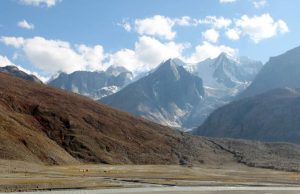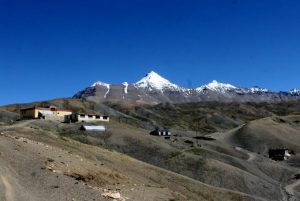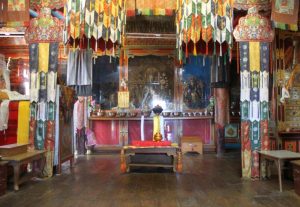Lahaul Spiti is one of the less explored travel destinations in India. It is gaining recognition steadily due to it’s stark terrain, high mountains, crystal clear lakes , wild rivers and remarkable local cultures. It is very sparsely populated and is the fourth least populated district in India.
How To Reach Lahaul Spiti
The only mode of transportation is via road. Lahaul is connected to Manali via Rohtang Pass which is a popular tourist destination by itself. Spiti is connected to Kinnaur at Sumdo where the National Highway 22 connects it with Kinnaur. Lahaul and Spiti are connected to each other via Kunzum La pass near Batal.
Nearest airport is Bhuntar airport at Kullu. Nearest railway stations are Shimla, Chandigarh and Jogindernagar.
Check out this page for bus schedules in Kaza
- Shimla to Kaza – 412 km, all weather road. Most of the road is in good condition apart from a few stretches which face frequent land slides.
- Shimla to Keylong – 375 km, It remains closed during winters due to snowfall at Rohtang.
- Manali to Kaza – 201 km, Opens in mid June till October till Kunzum La is open.
Weather 
Lahaul Spiti district is a high altitude desert region and is mostly quite dry with little rainfall. The whole are is enclosed between high mountain ranges which remain covered with snow and glaciers for most part of the year. Of the two, Spiti (average elevation 4270 m) is comparatively the drier place with lesser amount of rainfall. Average annual rainfall is just 170 mm. Lahaul (average elevation 3400 m) is greener but not by much. Most rainfall hppens between July and early September. High mountain ranges enclose the whole area which can make access difficult even in good weather. Minimum temperature even in inhabited areas routinely goes and stays below freezing point during winters and sometimes during rest of the year too.
Highest mountain pass in Lahaul Spiti is Kunzum La at 4551 m near Chandrataal Lake and Batal. Highest mountain peak is Gya at 6,794 m. More details here
Flora and Fauna
Lahaul Spiti is the habitat for numerous extremely rare animals and plants, many of which are not found elsewhere. Some of the important animal species are snow leopards, argali, Tibetan antelope, musk deer, brown bear ibex, Himalayan wolf and kiangs.
Snowline starts at 5000 m and almost all plants grow only below this altitude. Even then, due to dry weather and high average altitude, trees are found only in lower altitude areas and rest of the flora consists of some hardy shrubs, herbs and wild flowers like Crepis flexuosa, Krascheninikovia ceratoides, Caragana brevifolia, Seseli trilobum, Ausinia thomsonii and among others. Many of these are used in herbal medicine, fodder and fuel by locals. People farm wheat, cabbage, potatoes, onion and a few other crops in lower reaches.
People and Culture

For an outsider, the language, people and culture of Lahaul Spiti may seem similar, but they can vary a lot even among neighbouring villages. Due to proximity with Tibet, people of Spiti share a lot of Tibetan traits, language and customs while Lahauli people have a mix of Indo-Aryan and Tibetan. Languages even though different, belong to the Tibetan family.
Bhotia families in Spiti follow the traditional Tibetan heritance system in which eldest daughter inherits the mother’s jewellery, eldest son inherits family property and the younger siblings don’t get anything. Social security system of Gompas is an important source of support in local communities. Polyandry was a common system in Lahaul but it’s almost out of fashion right now.
Lifestyle
Basic lifestyle in Lahaul and Spiti is largely similar due to similar terrain and weather conditions. Most people depend upon agriculture and animal rearing (goats, yaks, sheep) for their livelihood. Tourism, handicrafts and jobs in government are gaining numbers too. Houses are more or less constructed in same Tibetan design with flat roofs apart from a few superficial differences. Fuel in form of wood, straw and dung is stored on roofs.
Religion
Buddhism and Hinduism are two major religions most people follow a mix of the two. ‘Lung Pe Chhoi’ similar to Bön religion of Tibet used to be popular before these two. Followers of this religion regularly offered animal and human sacrifices to spirits which were believed to inhabit natural world.

Bhotia families in Spiti follow Gelugpa Buddhism from Tibetan Buddhism. A number of important Buddhist monasteries are located in Ki, Kaza, Dhankar and Tabo. Lahauli people mostly follow Drukpa Kagyu order from Tibetan Buddhism. Then there are some temples which have a mix of Hindu and Buddhist idols and customs. Trilokinath Temple is one of the more famous ones.
Festivals
People in Lahaul Spiti celebrate different festivals at different times and they differ among communities too. Fagli is an important Lahauli festival celebrating New Year according to Tibetan New Year between February and March. Losar (Halda) is another important festival celebrated by lighting communal bonfires between January and February in which people pray to Shiskar Apa (Vasudhara), goddess of wealth. It’s exact date is determined by Buddhist Lamas
Tourism in Lahaul Spiti
Due to it’s sensitive location, Lahaul Spiti remained closed for tourists and access was opened only a few years back. Since then it has rapidly gained popularity and has become one of the more popular tourist spots of India. Other pages in this website (Lahaul , Spiti, Kalpa )contain details about some of the tourist places and activities in the region. Check this link for some sample travel itineraries for the region.
Lahaul Spiti is an excellent destination for adventure tourism and activities like trekking, hiking, camping, mountain climbing and river rafting among others. The cultural aspect like Buddhism, meditation and volunteer activities also draw a large number of tourists.
